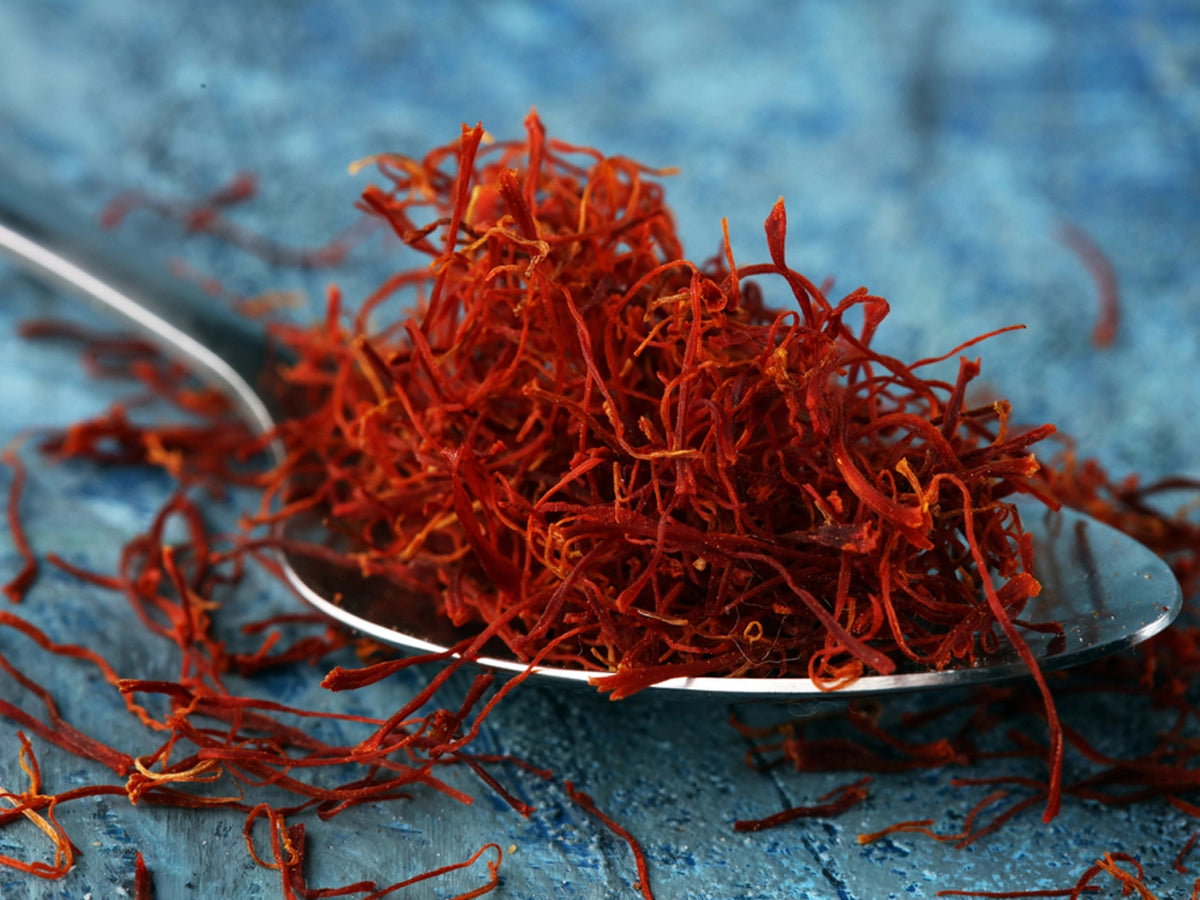How to Grow
Step-By-Step Guide on How to Grow Kesar (Saffron) at Home & Tips on Planting & Harvesting
“Oh, dear, the color of your love is saffron …… and as I touch it, it smears me too”
Does the above line ring a bell?
It’s just a translation of one of the most-loved Bollywood songs of 2022 – Kesariya tera ishq hai piya…Rang jaau jo main hath lagau
The saffron color is used here to express love because it stands for the sunrise, light, sacrifice, and purity. This color, according to the color vibration therapy, is associated with the second chakra (Svadhishthana or the sacral chakra) in our body that resonates with bliss—both mental and physical.
Early accounts claim that influential figures from history employed kesar or saffron to treat their illnesses. Kesar has long been seen as a representation of both magic and love.
Isn't it remarkable that the flower from which the color saffron originates is revered as a symbol of love and is also used in our cuisines?
The mesmerizing honey fragrance of kesar flowers is used to produce the kesar spice that adds a rich aroma to dishes like biryani, kheer, paella, etc.
This blog will unravel the growing techniques of the rare and the most expensive spice in the world – kesar. We will discuss the following: -
- Fascinating facts about Kesar or Saffron
- How to grow kesar at home easily
- How to take care of kesar plants
- Key benefits of kesar or saffron
Hope you are excited to discover more about kesar! Let’s get started.
Fascinating Facts about Kesar or Saffron
- The name Saffron perhaps comes from the old French word "safran," which is based on the Arabic word "za'farn." Za'farn comes from the Persian word zarparan, which means "gold strung." It can allude to the flower's golden stamens or the golden hue it produces when used as a flavor.
- Where did the original Kesar plant come from? The majority of the research says saffron originally came from Iran.
- Mesopotamia and Greece are also believed to be potential locations for the origin of this plant.
- There is a strong chance that Iran is the birthplace of Kesar because this country still produces over 90% of the world’s total saffron.
- It takes around 150 to 200 flowers to produce just one gram of this spice that we love in various dishes. Why wouldn’t it then be costly?
- Do you know that the hay-like fragrance of kesar strands or threads is a result of the presence of the phytochemicals picrocrocin and safranal?
- Connoisseurs frequently compare the fragrance of saffron to metallic honey with grassy or hay-like undertones.
- Did you know that the Romans bathed in saffron?
- Kesar is also believed to work as a hangover remedy.
How to Grow Kesar at Home Easily
Saffron, an exotic spice with a distinct aroma and flavor, can be grown at home with a few simple steps. Follow the steps below to easily grow kesar or saffron at home: -
Buy crocus corms
Crocus corm is the bulb of the saffron plant. You have to purchase fresh corm to start your saffron plant.
Select a location
Be it indoors or outdoors, select a location that receives bright sunlight and has well-draining soil. Dig the soil or opt for tilling it to help the soil loosen up.
Improve soil
Add organic materials to the soil to improve its fertility. Till the area where you want to plant your corms, then mix in 10 inches of organic materials. You can make use of peat, compost, or chopped leaves. The crocus bulbs can survive the winter thanks to the nutrients from this.
Choose containers
- Planting kesar in containers might be a suitable choice for you if rats or other pests are a persistent issue in your garden.
- You can either buy a planter with a minimum depth of 6-8 inches or make your container. To make an easy plant pot, you'll need topsoil, weed cloth, duct tape, and plastic milk crates.
- Using weed cloth and duct tape, line plastic milk crates.
- You should put about 5 inches of topsoil inside your milk crates.
- Ensure there are drainage holes in your planter. Make drainage holes in that plastic milk crate.
Planting time
Plant kesar before the ground freezes or before the harsh winter arrives. Your corms should be planted 6–8 weeks before winter steps in for optimal results. This might happen in October or November.
Planting saffron bulbs
- First, organize your crocus corms into groups.
- Saffron blooms will flourish better if you place them in clusters as opposed to rows. Plant your crocuses in groups of 10 to 12 about 3 inches apart from one another.
- If you are using a pot or milk crate, remember they can store only one group of 10-12 corms. If you want to plant more, then use more containers.
- Corms should be planted 3 to 4 inches deep. Dig little holes that are 3–4 inches deep and then place one corm in each hole, with the sharp end upward. Add soil over each bulb.
- In the case of containers, set your corm on top of the 5 inches of soil you had previously applied. Then add another 2 inches of soil over your corms.
Water the plants
- You have to water the kesar plant throughout the fall. Saffron grows best in the autumn, so it's crucial to keep the soil moist but not soggy during this period.
- Water your corms once or twice a week to start.
- Put two fingers into the soil to check the moisture many times per week.
- Start watering only once a week if there is standing water more than a day after watering.
- Start watering three times a week if your soil is entirely dry within a day.
Fertilize once per season
- Good fertilizer options include old manure, compost, and bone meal.
- If you reside in a region with a brief, mild spring, fertilize your kesar plant in the first few weeks of autumn.
- If you live in an area with a long, mild spring, fertilize your kesar plant after it has finished blooming.
- With timely fertilizing, your saffron plant will be able to survive until the following year by building up a substantial store of carbohydrates.
Continue caring
Saffron flowers are simple to grow if you take proper care. Crocus flowers should start to bloom 6 to 8 weeks after you plant your bulbs, but occasionally they won't start to bloom until the following fall, a full year after you planted your bulbs.
Harvest and store
- The outcome of your harvest is not ideal: each corm will only produce one bloom, and the bloom only yields three saffron stigmas. Consequently, your crop will only produce a meager amount of usable saffron. Your crop will only yield a small amount of useful saffron.
- On a sunny day, when the purple Kesar flowers have fully opened, delicately pluck the vibrant orange-red stigmas from the center of each bloom.
- After meticulously removing each stigma from the saffron, spread them out on paper towels and store them somewhere warm and dry.
- Until they are entirely dry, leave them alone for one to three days.
- Always store saffron in a cool, dry place
- You can safely store this kesar in an airtight container and use it for five years.
How to Take Care of Kesar Plants
Read the following care instructions to grow kesar plants: -
Sunlight
You run the danger of receiving a poor crop if the saffron crocus plants don't receive at least four to six hours of direct sunlight during bloom time. This plant requires little shade and lots of bright light to thrive.
Location
Choose a location where there is surety of at least six hours of bright sunlight. Your balcony, windowsill, backyard, front garden, porch, or terrace can be great locations if they receive copious amounts of sunlight.
Soil
When it comes to soil, surprisingly, saffron crocus is not very demanding. It can grow in any well-draining soil type. However, the best kind of soil for growing saffron or kesar plants is sandy, loamy, and humus-rich. The soil pH should be between 6.0 and 8.0.
Water
In general, saffron crocus plants are moderately drought-tolerant, but too much rainfall can rot the bulbs. Light watering may be necessary only in cases of dry spell, otherwise; they may survive on only natural rainfall.
From planting until harvest, kesar plants require a moderate supply of water. Just about half-an-inch of water per week is sufficient. Once the plant enters its dormancy, it doesn't need watering at all.
Temperature
Research has demonstrated that the optimal saffron growing temperature for blooming is between 17 and 25 degrees Celsius. The flowering may not occur at temperatures higher than 30 degrees Celsius.
Fertilizer
This plant flowers quickly, so it may not require fertilizer. However, when planting Saffron Crocus bulbs, adding organic fertilizer to the soil can be beneficial. One inch of compost should be applied. As an alternative, add some bone meal to the soil before planting.
Mulching
Harsh and frigid winters are not good for saffron plants. So, if you expect the temperatures to drop drastically, you can help protect the plants by mulching the area surrounding them with compost or straw.
Pruning
Although the saffron crocus does not require pruning, when the springtime leaves turn yellow and fall off the plants, it is necessary to carefully dig up the corms.
Pests & Diseases
Saffron plant is luckily and naturally resilient and disease- and insect-resistant. There aren't many predators for saffron crocuses. This tough plant is occasionally, and infrequently may be harmed by rot or mites in addition to the hungry rabbit or gopher.
Key Benefits of Kesar or Saffron
Kesar or saffron is a world-renowned spice. The nutritional profile of this spice (per 100gms) is mentioned below, along with its probable health benefits: -
|
Calories |
310 |
|
Carbohydrates |
65gm |
|
Calcium |
111mg |
|
Fat |
6gm |
|
Iron |
61% |
|
Magnesium |
66% |
|
Potassium |
1724mg |
|
Protein |
11gm |
|
Sodium |
148mg |
|
Vitamin A |
10% |
|
Vitamin B6 |
50% |
|
Vitamin C |
134% |
May aid in arthritis
Saffron contains crocetin, which can improve cerebral oxygenation and aid in the treatment of arthritis. Studies have shown that Meadow Saffron is quite effective in treating gout. However, older people with kidney, liver, or bone marrow issues shouldn't take this specific form of saffron.
Heals wounds
Kesar tends to re-epithelialize burn wounds. That’s why when a paste of water and kesar is applied topically to the wounded area, it heals faster.
May treat asthma
The antioxidants in kesar make it perfect for treating asthma or other respiratory issues. Traditional medicine has been using saffron for treating respiratory diseases for ages.
Aids in digestion
Not only kesar can aid in digestion but also treat many other digestive issues. This is as a result of its antioxidant, radical scavenger, and anti-inflammatory activities. Additionally, it is effective in treating peptic ulcers and ulcerative colitis.
For cancer prevention
Crocin, a substance found in saffron, is useful for stopping the spread of colorectal cancer cells. Prostate cancer and liver cancer cases have both demonstrated the same results. In some circumstances, saffron can be used to cure skin cancer.
Saffron has anticancer qualities since it is high in carotenoids. According to studies, kesar can also prevent the growth of two different types of human cancer cells. Moreover, Kesar’s crocetin acid can stop the development of pancreatic cancer.
Flawless radiant skin
Kesar can do the following to your skin:
- Improve complexion
- Reduce dark circles
- Cure infection of the erysipelas
- Reduce melanin production, lightening the skin
- May prevent melanoma or skin cancer
But first, consult a doctor if you face any issues.
Good for the eyes
The capillary network and ocular responsiveness are strengthened by kesar. The powerful nutrients in kesar can prevent retinal degeneration and eyesight loss. Kesar supplements may also increase macular thickness and stop photoreceptor damage
Helps sleep well
Insomnia can be bothersome and might prevent us from being very productive during the day. People who regularly use saffron can heal their insomnia and help them fall asleep. It controls sleep patterns as well.
Getting those desired kesar threads to use in food may be a huge process, but growing this flower at home is no less than a prized possession. The sweet, honey-scented fragrance of Kesar flowers would make your indoor or outdoor garden no less than heaven! So, if you want a flowering plant that can be cultivated easily and grows readily, opt for the kesar plant.
Happy gardening!
FAQs related to Kesar
What are the health benefits of kesar (saffron)?
Kesar has many potential health benefits like a healthy digestive system, better heart condition, immunity boost, refreshing mood, refined cognitive functions, etc.
Why is kesar the most expensive spice in the world?
Kesar is the most expensive spice in the world because it is harvested from a rare flower called the saffron crocus. Saffron crocus grows only in a few regions of the world, such as Kashmir. Harvesting kesar is a labor-intensive process, as each flower only produces three threads. Due to its rarity and labor-intensive harvesting process, kesar is usually costly.
How much kesar should be consumed daily?
For medicinal purposes, one should take 1/8 teaspoon (1 gram) of kesar daily. But always consult your physician first before making such changes.
What is the shelf life of kesar?
Kesar has a long shelf life of up to two years if stored in a cool, dry place, away from direct sunlight.
How should Kesar be stored?
Kesar should be stored in an airtight container. Keep that container away from sunlight in a cool, dry place.
What are the side effects of Kesar?
Kesar is generally safe when taken in small amounts. However, it may cause allergic reactions in some people and may interact with certain medications. Therefore, consult a doctor before making any dietary changes.



